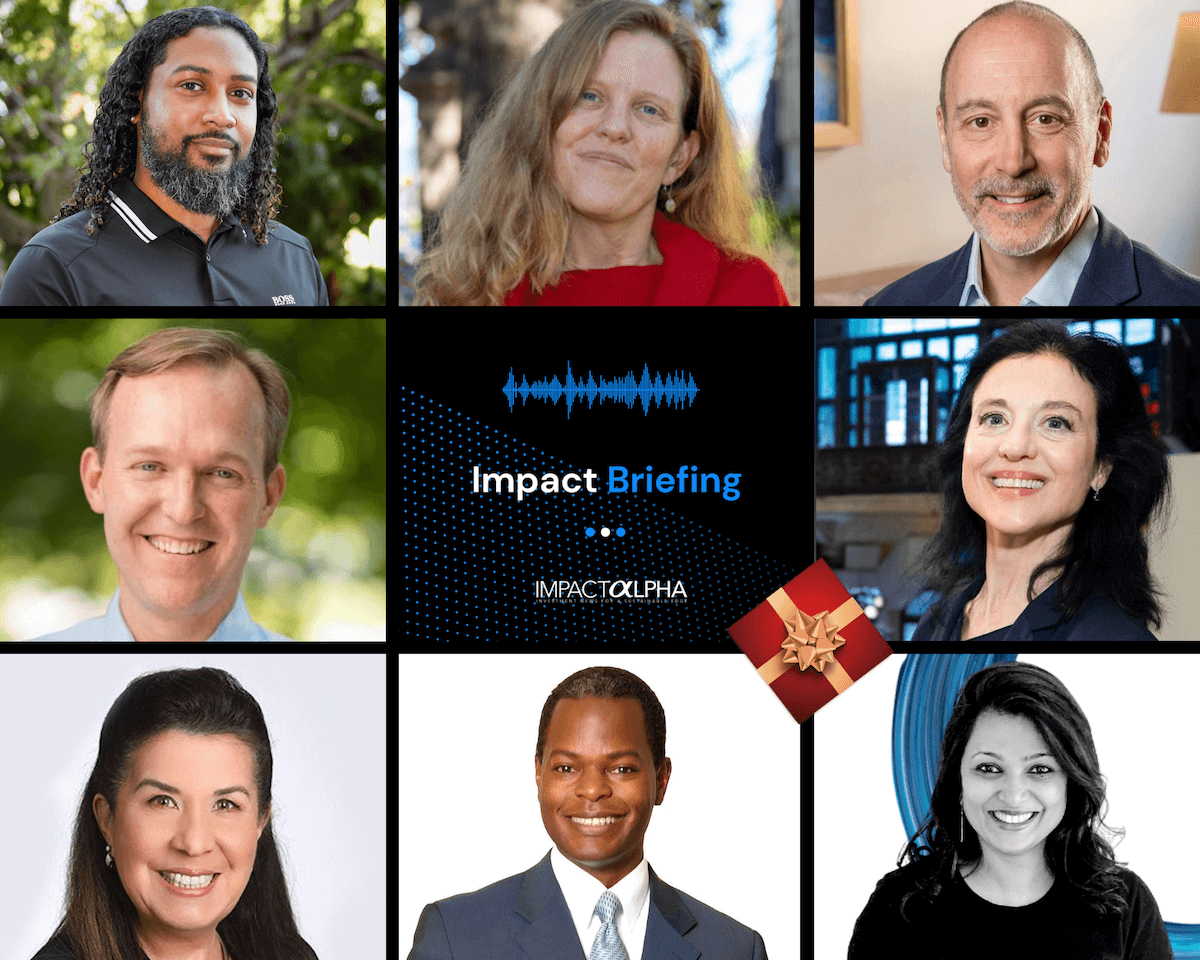ImpactAlpha, Dec. 20 – The push: Limited partners and regulators are demanding more rigorous impact reporting. The pull: Fund managers are finding alpha in impact.
Jeffrey Ubben may have thrown in the towel on his Inclusive Capital Management, and BlackRock’s embattled Larry Fink has banished the term “ESG,” but the long term trends driving impact investing are only deepening.
Indeed, the quest for proactive social and environmental impact in private and public asset management attracted new adherents, after an orchestrated campaign against ESG sought to take down the more limited practice of considering only environmental, social and governance risks to companies themselves.
The attack on “woke capitalism” inadvertently made finding alpha in impact a respectable investment strategy. From a source of asset growth in a tough fundraising environment and a driver of enterprise value in portfolios to evolving practices for impact measurement and management, impact is the new game in fund and asset management.
Pitchbook data shows $741 billion in assets under management controlled by private market impact fund structures (the GIIN’s $1.2 trillion figure includes investment opportunities not found in private fund structures, including public equities). Of that total, $200 billion is in dry powder waiting to be allocated. Fundraising in 2023 year lagged 2022’s record setting haul.
“Looking at overall fundraising for impact funds,” Pitchbook’s Hilary Wiek wrote in a briefing, “the long-term trend is clearly up and to the right, with more funds and more assets being raised.”
Impact rises from the ash of the ESG battles
The backlash against ESG has done little to hamper the growth of impact investing. It may even be driving some institutional investors toward investments that take more intentional aim at positive measurable social or environmental impact.
Take public equities. Seven in ten institutional investors that participated in Vontobel’s 2023 Impact Investing Survey said they plan to increase their allocations to impact investing in public markets. Moving the dial is a worthy task: the total market capitalization of companies listed on stock exchanges worldwide exceeds $100 trillion.
Yet only 10% of impact funds in Phenix Capital’s database of 2,600 funds invest in listed equities. And only 14% of the $1 trillion impact investing market, according to the Global Impact Investing Network, is invested in public equities.
Impact investors took steps this year to clarify how impact strategies in listed equities differ from ESG approaches and other sustainability-related strategies, including an active theory of change, intentional engagement strategies and performance measurement. The guidance from the Global Impact Investing Network “challenges asset managers, in particular, but really all of us as participants in this market, to really think through the theory of change that takes you from the asset owner’s capital to the outcomes we’re all trying to work towards,” Jeff Finkelman of Fiduciary Trust told ImpactAlpha.
The coordinated backlash did have a chilling effect on shareholder action. Support for climate and ESG resolutions flagged in 2023 as major asset managers recalibrated their proxy voting strategies in the face of the campaign by Republican state attorneys general, including threats of legal action.
A BNP Paribas survey of institutional investors earlier this year showed a massive attitude-shift in favor of impact investing, suggesting the pursuit of positive-impact outcomes will overtake the more limited “ESG integration” as sustainable investors’ preferred approach.
“ESG is a system of measurement, not a strategy,” says Tensie Whelan of NYU Stern’s Center for Sustainable Business. Whelan urges companies and their investors to drive real-world value by incorporating strategies for sustainability and diversity, equity and inclusion.
Impact is a growth market in private equity
At Brookfield Asset Management, “decarbonization, deglobalization and digitalization” are fueling growth, according to CEO Bruce Flatt. At KKR, Pete Stavros has staked out ownership for rank-and-file workers as a driver of value. And TPG is touting that it more than doubled the “impact yield” of its $2.1 billion Rise Fund one.
In its surprisingly optimistic Sustainability Trends report in September, Al Gore’s Generation Investment Management cited ambitious industrial climate laws in the US and Europe and other policies that are creating opportunities to invest in the energy transition. “We’re calling a moment here.” Generation’s Justin Gillis told ImpactAlpha.
The moment is becoming a movement. Private equity firms are shedding their “barbarians at the gate” image as they chase the alpha, and assets, in impact. KKR has hired a trio of climate experts to prep a $7 billion fund to invest in global decarbonization opportunities.
Not all PE firms have gotten the memo, as NYU’s Whelan explained in a series of guest posts on ImpactAlpha. And the impact-focused funds of the early movers are, in many cases, a small portion of their total assets under management. But quarter after quarter, impact funds are driving growth and returns.
PE firms are also tracking and reporting on their results. TPG, for example, claims $9 billion in “quantified impact” across its series of Rise funds. That’s the firm’s estimate of the economic value of the social impact associated with the business outputs of its portfolio companies. For example, the “impact yield” of Rise I, TPG’s $2.1 billion inaugural impact fund, was up 113% last year.
- “Private equity firms see robust demand for impact funds, despite headwinds”
- “Private equity giants double down on the low-carbon transition and impact investing”
- “More private equity firms embrace impact as a path to outperformance”
Impact as a driver of enterprise value
Worldwide, 20 million employees work at 40,000 companies owned, at least in part, by some 10,000 private equity firms. For PE managers, “sustainability strategies can serve as growth levers that can unlock value within organizations, drive top-line growth, and tackle material risks to prevent future value destruction,” says NYU’s Whelan.
Interpreted stringently, very few businesses qualify for the “impact” label. Used loosely, investors can overstate their impact, a practice known as “greenwashing.”
“There’s a massive opportunity in the middle,” says Vistria’s Kelly McCarthy, “whereby you could think very differently about impact in terms of value creation.” Many more companies “have all the right ingredients,” she says, including mission-alignment, competent teams and systems in place to execute on environmental, social and governance issues.
Chicago-based Vistria analyzes the impact potential for value-creation of each deal as a middle-market private equity firm. Says McCarthy, “If we put something additional into those companies with an impact lens, we could optimize impact for a much larger group of people.”
- “Architect of IRIS+ is ready to put impact management theory into practice”
- “More private equity firms embrace impact as a path to outperformance”
- “Private equity impact funds keep coming”
Measuring and managing impact as an opportunity, not a burden
Some fund managers link staff incentives to impact results. Others verify outcomes with multiple stakeholders. Many regularly assess impact risk. As investors increasingly expect visibility into outcomes, fund managers are seeking to outperform in measuring and managing impact.
By listening to customers, fund managers and their portfolio companies are realizing tangible benefits. After successfully implementing the practice with its first fund, Colombia’s Alive Ventures will make voice-based surveys of customers of its portfolio companies a staple of its second fund, and will tie part of the fund’s carry, or profits, to its performance on impact.
Impact reporting has come of age. Once a practice primarily of nonprofits, the biggest private equity firms in the world now publish fund-specific and sometimes company-wide impact reports; many are even slipping impact reporting into their broader annual report. ImpactAlpha worked with BlueMark, which has assembled impact reporting best practices, to assess the quality of fund- and enterprise-level impact reporting (Bluemark is an ImpactAlpha sponsor).
ImpactAlpha in 2023 dug into reports from Bain, Apollo, TPG and KKR, as well as Candide, MicroVest, Echoing Green and other investment managers, including Elevar Equity, Veris Wealth Partners, Atlas Impact Partners, Calvert Impact and Runway.
- “How three impact investors engage their most important stakeholders to validate impact”
- “Streamlined, standardized and benchmarked: Optimizing impact data for capital markets”
Mandatory disclosure is coming to a fund near you
If investors aren’t already pulled by the opportunities in impact, they’ll soon be pushed by regulators.
California ‘s landmark climate disclosure law, SB 253, will require more than 5,000 large public and private companies doing business in the state to report their direct and indirect emissions and disclose climate-related risks and plans to address them. The US Securities and Exchange Commission is finalizing its long-delayed rules for climate and human-capital disclosures.
In Europe, the Sustainable Finance Disclosure Regulation fully kicked in this year. The labeling standards have helped cut through rampant greenwashing in funds marketed as ESG or sustainable. Under the EU’s Corporate Sustainability Reporting Directive, or CSRD, large publicly listed companies – including foreign corporations – will need to begin reporting environmental, social and governance metrics next year.
“We are on the precipice of impact transparency, however imperfect it may be,” said Fran Seegull of the US Impact Investing Alliance on ImpactAlpha’s “State of the Field” call in October. “Raising the bar over time on that regulatory disclosure will set the tone for the next decade of impact transparency, accountability, and equity.” (The Alliance sponsors ImpactAlpha’s “Policy Corner.”)











